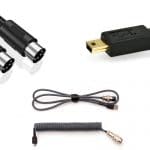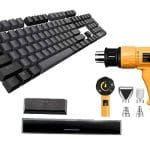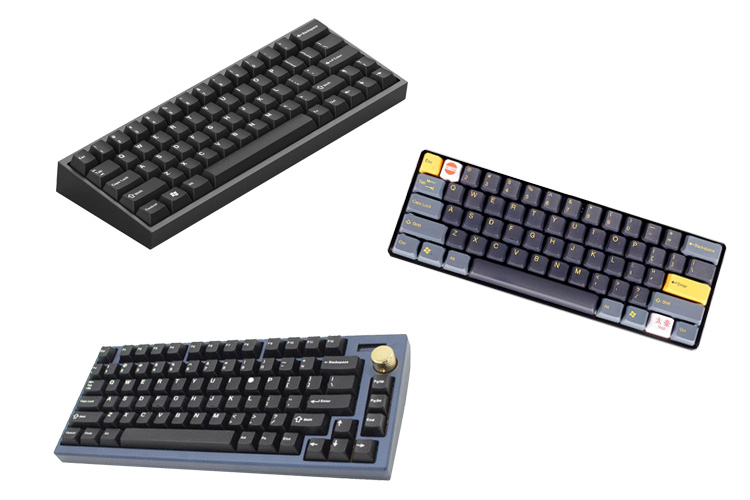
Compact keyboards are becoming the norm in the keyboard community, and most enthusiasts are gravitating towards 75% and 60% keyboards. But with the many variations of these two keyboard sizes, choosing between the two can be a bit challenging.
75% keyboards are suitable for gamers and users who rely extensively on the function, navigation, and arrow keys. On the other hand, 60% keyboards will better suit users who value desk space and portability. It is recommended to choose the keyboard size that best fits your needs or try out each one to see which feels better.
Both keyboard sizes have plenty of followers. Some swear by 60% keyboards, while others claim that 75% is the smallest keyboard size that they will use. In this article, we will be helping buyers decide which keyboard size best fits them.
We will be summarizing the selling points of each keyboard size, popular models that use them, and their downsides. And by the end, our readers should have a better understanding of which keyboard size fits their needs. So without further ado, here is our comparison of 60% and 75% keyboards.
Summary of 60% Keyboards
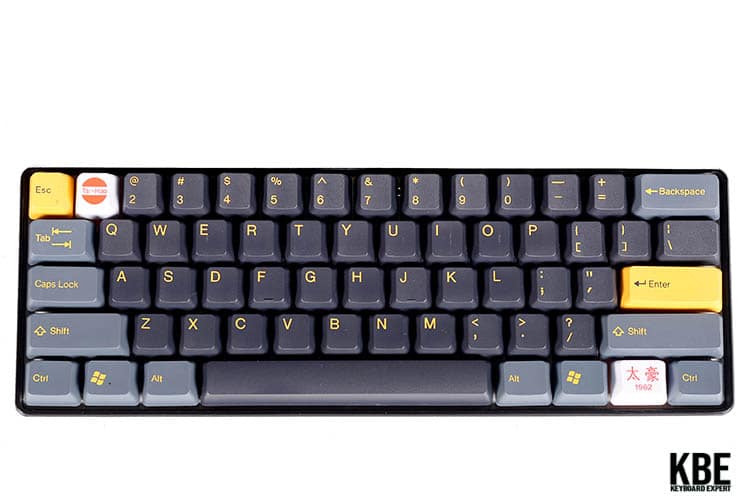
60% keyboards are compact mechanical keyboards that usually have at least 61 keys. They get rid of the lesser-used keys such as the F-keys and prioritize essential areas such as the alphas and the modifiers. By removing a large chunk of the keyboard, 60% keyboards manage to achieve a significantly smaller footprint than full-sized keyboards.
Many users might think that 60% keyboards are novelty items. However, these keyboards have been proven to be reliable workhorses once you get used to them. You can still access all physically missing keys via secondary layers. And since most 60% keyboards are fully programmable, they can potentially increase productivity by minimizing wrist movement.
60% keyboards also have additional benefits. Most 60% of keyboards are lightweight and easier to carry than larger keyboards. And when paired with Bluetooth functionality, they can be the perfect companion for a mobile setup.
Of course, the keyboard’s weight will still depend on the rest of its components. Many custom keyboards utilize an aluminum case and a brass weight, contributing to a heavier keyboard.
And lastly, 60% keyboards are highly preferred by gamers, and they take up less space giving more room for wider mouse movement.
Despite their many benefits, some users still prefer using larger keyboards. Some scenarios and tasks will require physical F-keys and arrow keys, both of which are missing in most 60% keyboards. Also, some users are already used to larger form factors and are not willing to relearn a smaller keyboard layout.
In terms of layout options, 60% keyboards usually utilize the ANSI or HHKB layout. ANSI layout is the most common layout found in the majority of keyboards. HHKB, on the other hand, is less common due to its more complicated design.
It was developed by Happy Hacking Keyboard and was meant to deliver a more universal and efficient typing experience. HHKB keyboards only have five keys on the first row: a 7u spacebar and four modifiers that are usually the control, function, alt, and Windows key.
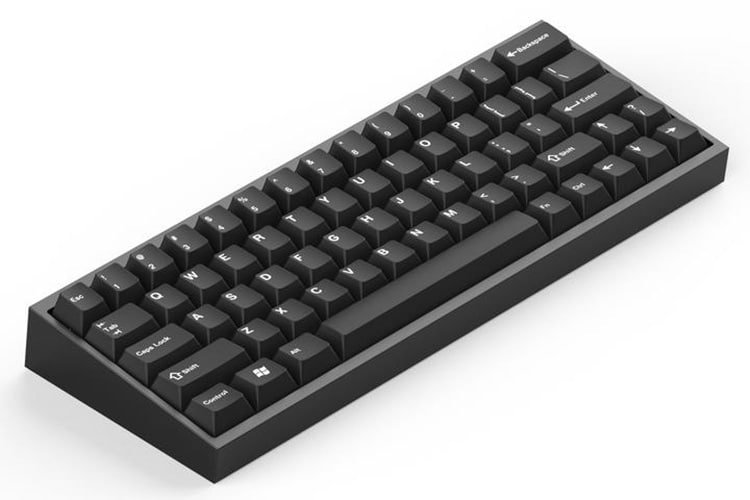
Also, HHKB keyboards only have 60 keys compared to ANSI keyboards that usually have 61 keys. With fewer keys, many regard HHKB keyboards to have a more compact and sleek design. Some HHKB keyboards also have a 1.5u backspace and a 1.75u right shift, which makes the adjusting period longer for people who are used to the ANSI layout.
Lastly, 60% keyboards can be modified by the user to support extra keys such as arrow keys. However, 60% keyboards must make some compromises since their small form factor cases do not give a lot of room for the user to play with.
To illustrate our point, let us take a look at the KBDFans Tofu60. It supports arrow keys at the cost of moving the “?” key to the right side and having a smaller bottom row. Some users may find it interesting that these keyboards can provide additional layout options. However, others might not want to go through the hassle and prefers having arrows keys out of the box.
Pros of 60% Keyboards
- Its smaller footprint saves on desk space
- Travel-friendly, especially if paired with Bluetooth functionality.
- Flexible in terms of layout.
- Great for gaming, especially for FPS games.
Cons of 60% Keyboards
- Does not have arrow keys (by default), navigation keys, and function keys.
- May take some time to get used to if you are used to full-size keyboards.
- Accessing secondary layers and macros can get a bit complicated for beginners
Popular 60% Custom and Prebuilt Keyboards
Prebuilt Keyboards:
- Anne Pro 2
- Ducky One 2 Mini
- Razer Huntsman Mini
- Glorious GMMK Compact
- Vortex Pok3R
- Royal Kludge RK61
Custom Keyboards:
- KBDFans Tofu60
- KBDFans TFV2
- KBDFans D60/D60 Lite
- Monstargears Sangeo60
- Cannonkeys Bakeneko60
Summary of 75% Keyboards
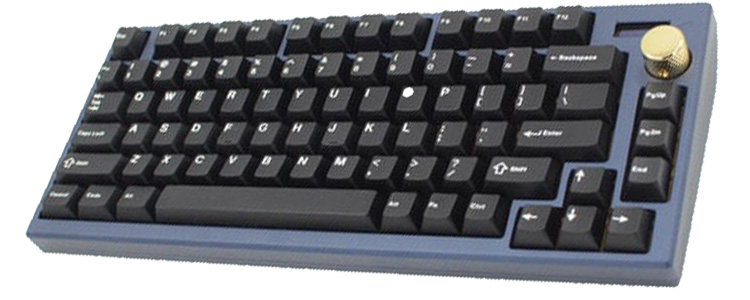
For keyboard enthusiasts who want to save space but can’t give up their arrow keys and F-keys, 75% keyboards are a popular choice. 75% keyboards have the same number of keys as TKL keyboards. The main difference is that the keyboard case is more compact, making the look of 75% keyboards a lot closer to 65% keyboards.
Unlike most small form factor keyboards, 75% keyboards have physical F-keys, arrow keys, and the home row cluster out of the box. The user no longer needs to make extra software and hardware modifications to access these keys. Additionally, many 75% keyboards are large enough to accommodate extra features such as a rotary encoder/knob and an OLED screen.
Just like with 60% keyboards, 75% keyboards also come in a number of different layouts. Some keyboards, such as the KBD75, are extremely compact. All the keys are clustered together with no spaces in between.
Alternatively, the exploded 75% layout separates the alphas, the F-keys, and the arrow keys. Many prefer the aesthetics and feel of the exploded layout since it doesn’t feel as cramped as the KBD75’s layout. Today, the exploded layout can be seen in almost every newer iteration of the 75% form factor.
75% keyboards have all the benefits found on 60% keyboards. They look great, are compact, and give plenty of room for other accessories on your desk. But with that said, some still prefer the smaller footprint of a 60% or 65% keyboard, and some even consider 75% too large and heavy.
In addition, the 75% form factor is not common in the prebuilt keyboard market. So unless you are fully invested in a full-blown custom keyboard, 75% keyboards may be harder to find.
Pros of 75% Keyboards
- Includes physical function and navigation keys
- Inclusion of unique features such as OLED displays and knobs
- Small form factor that conserves desk space
Cons of 75% Keyboards
- Significantly larger than 60% keyboards
- Not travel friendly
- Limited Third-Party case options and customizability.
Popular 75% Custom and Prebuilt Keyboards
Prebuilt Keyboards:
- Keychron K2/K3
- Royal Kludge RK84
- Keydous NJ80
- NuPhy Air75
- Iqunix L80
- Vortex Race 3
Custom Keyboards:
- Keychron Q1
- Idobao ID80
- Owlab Jelly Epoch
- Feker IK75
- Satisfaction75
- GMMK Pro
60% and 75% Keycap Compatibility

As mentioned earlier, 60% keyboards utilize two kinds of layouts: ANSI and HHKB. For ANSI 60% keyboards, most keycap sets should be compatible. They use standard size modifiers, which are included in all keycap sets.
HHKB keyboards, on the other hand, will be a bit more challenging. While they have fewer keys, some modifiers in the HHKB layout do not use standard sizes. Most HHKB keyboards use a 7U spacebar which does not always come with keycap sets. A 1.75U shift and 1.5u backspace keycap may also be required for some keyboards, such as the KBDFans TFV2.
As for 75% keyboards, the only uncommon keycap that it needs is a 1.75u shift for the right shift. Most modern keycap sets released by major keycap brands already include a 1.75U right shift key with their keycap sets. Overall, both keyboard sizes should be compatible with most keycap sets.
60% vs. 75% – Which Keyboard Size Should You Buy?
Both 75% and 60% keyboards are equally popular in the keyboard community, and both are also available in high-end and budget-priced configurations. So the deciding factors would be your personal preference and the applications you will use them for.
For users who are looking to use their keyboards with productivity apps and cannot live without their F-keys and arrow keys, 75% keyboards are the clear winner. However, users who prefer a smaller form factor and are willing to experiment and work around the limitations of a compact case should go with a 60% keyboard. We also highly recommend giving each keyboard size and form factor a try to see which one best fits your needs.


